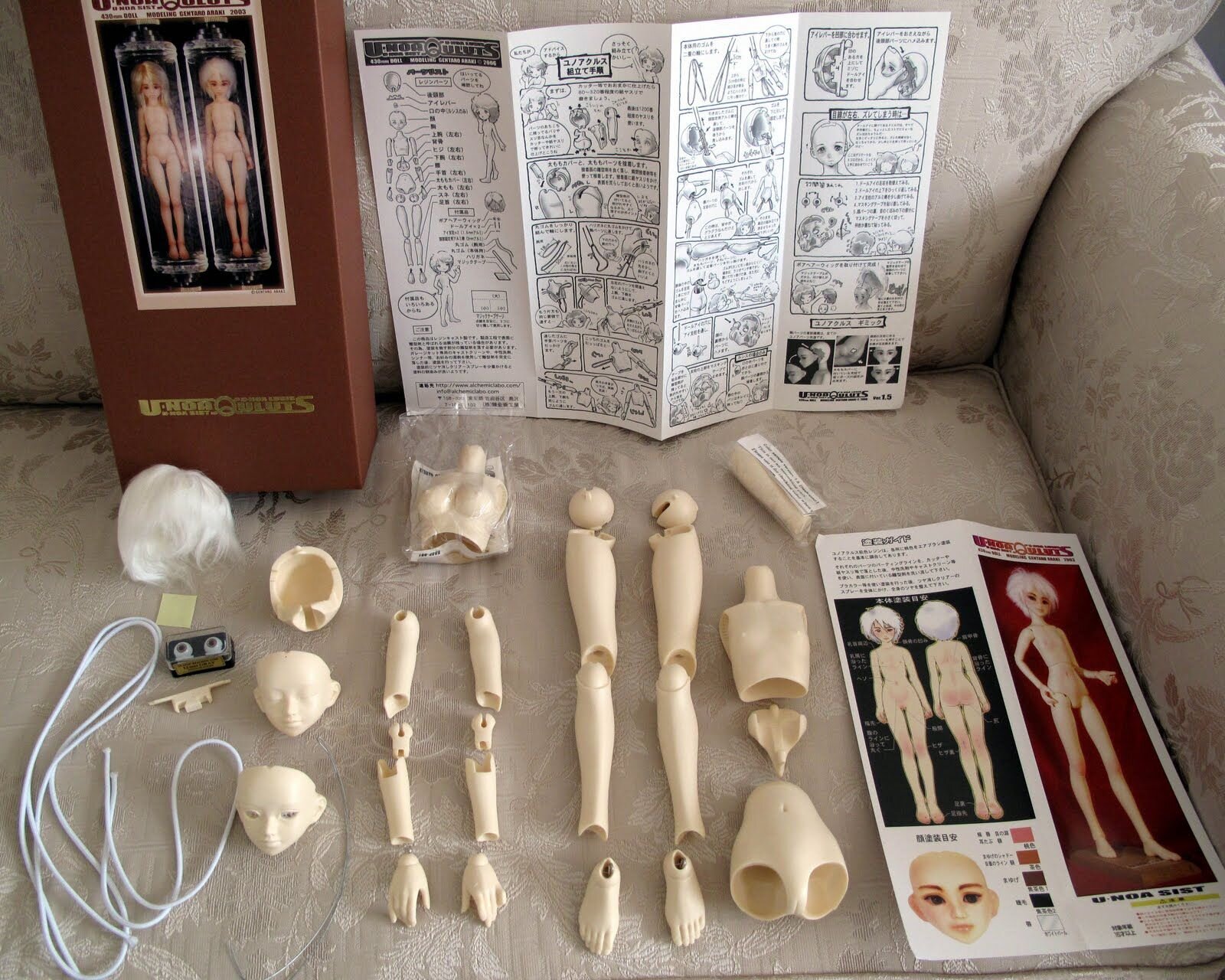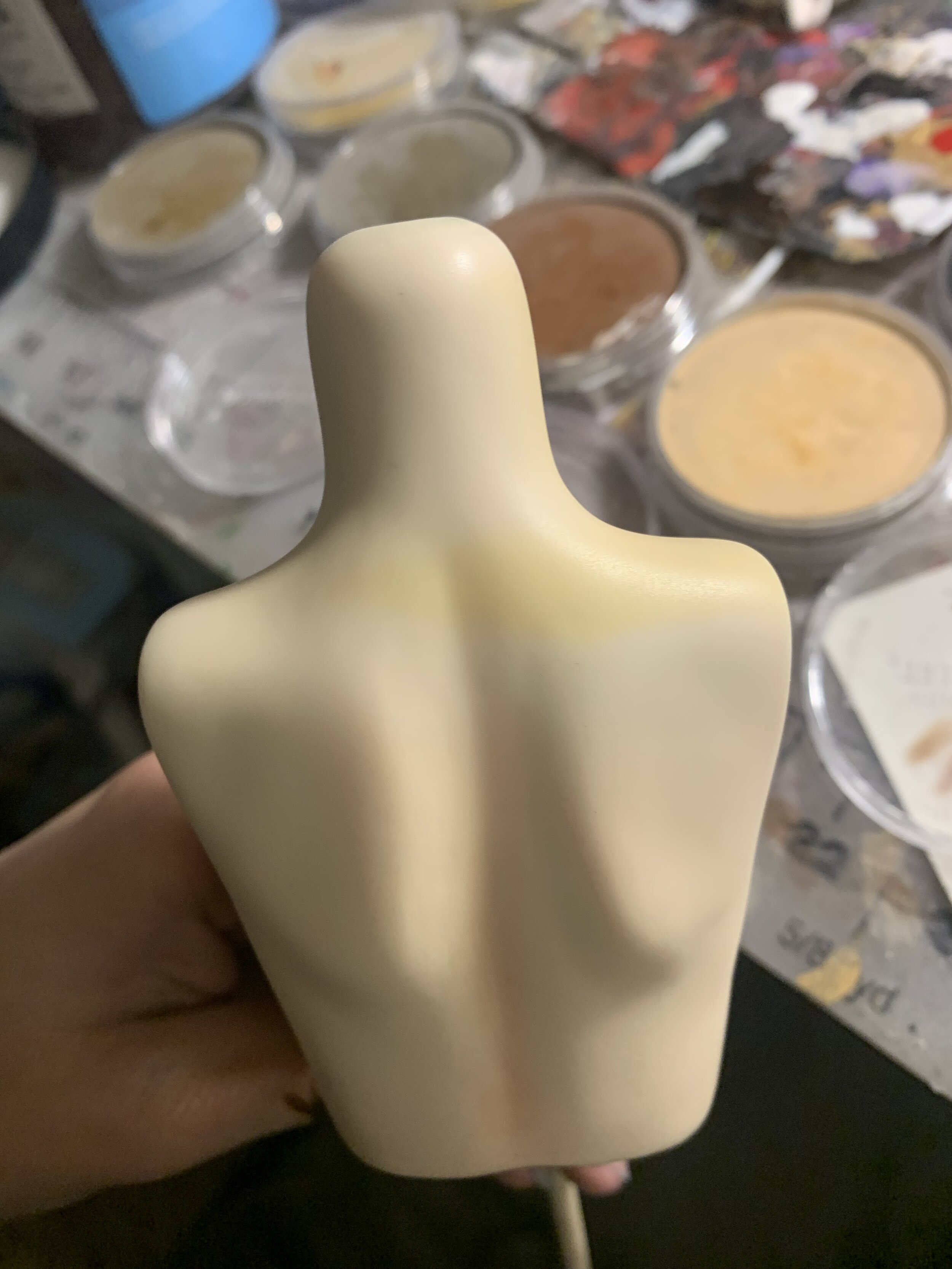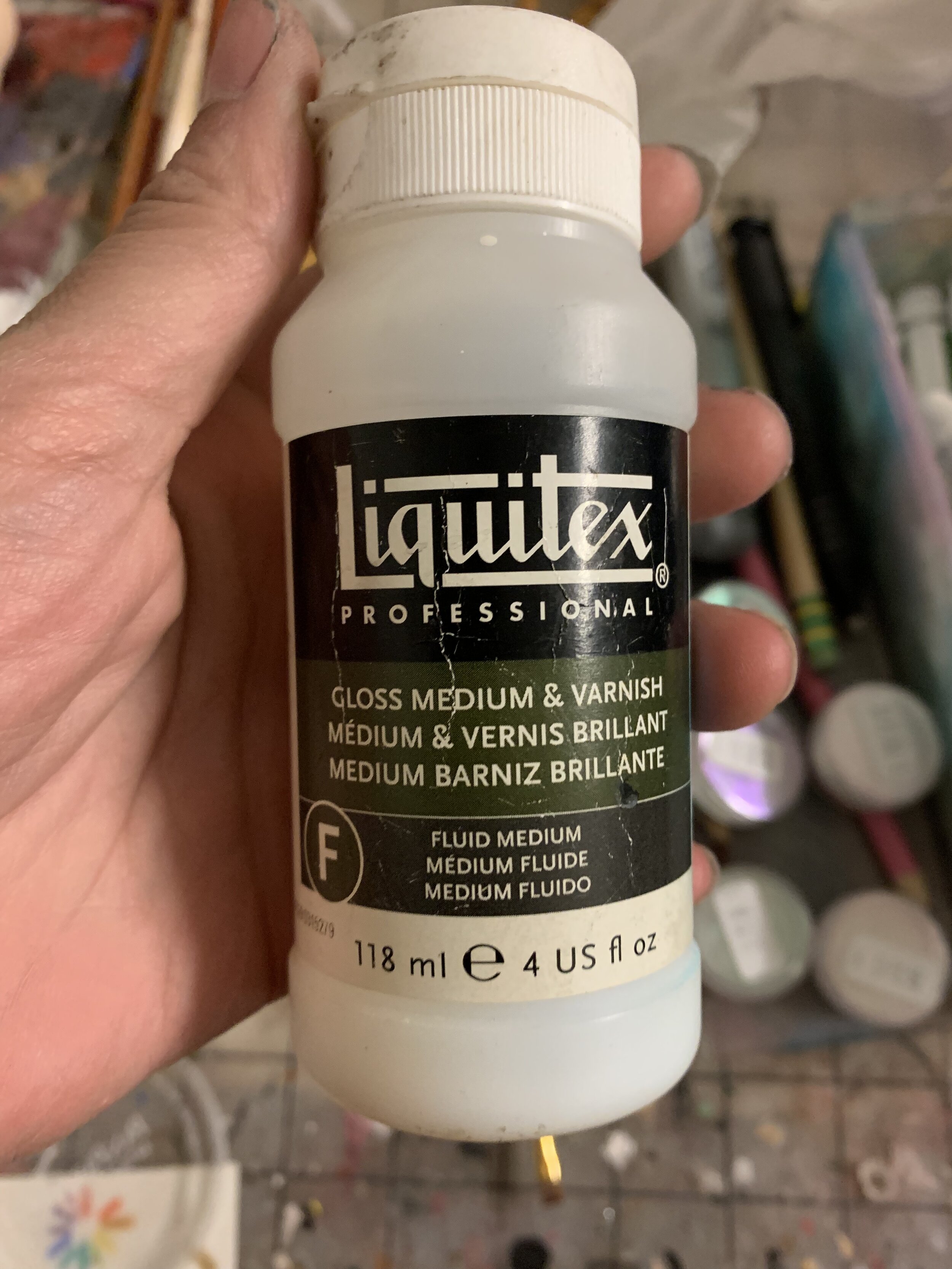Essential Materials for BJD Ownership and Maintenance
I’ve owned ball-jointed dolls (BJD) Since 2014, which makes about seven years as of this writing. As anyone who owns a BJD will know, these dolls are quite expensive and can demand a high level of dexterity and maintenance know-how to maintain.
Maintenance is a common subject for questions as a result: no one wants to break their special and expensive doll, which means not as many people take the risks to learn.
So I’m going to write a short guide on how to keep materials around for caring for your BJD, even if you’re not a professional collector. ESPECIALLY If you’re not a professional collector.
An example of a classic BJD, Unoa Sist.
This is a basic list of the things I recommend to have on hand if you own a BJD and want to be able to maintain them at home.
Exacto blade/Razor knife
Watercolor Pencils
Acrylic Paint
Matte and Gloss medium
Matte Finish Model Sealant (expanded upon below)
Organic Vapor Respirator (Yes, this means YOU.)
Elastic Cord appropriate to your BJD
90%+/- Isopropyl Alcohol
Magic Eraser/Melamine Sponge
Q-Tips/Cotton Buds
I will expand on these topics further down. Depending on what you’re intending to do with your doll and how new or old it is, you may not need all of these at once :)
It was -10 F outside. Much colder and it starts to affect the joint elastics after a while.
It’s important to note that I have a pretty active play style with these dolls: I pose them a lot, I take them outside, and I re-dress them pretty often. Some collectors prefer to treat these dolls like precious, fragile objects, wearing gloves and undressing them after every session of play, or placing them in climate and light-controlled areas.
These dolls are fragile like bones or ceramics are in that they’re fairly sturdy with fragile weak points. In ball-jointed dolls these areas are the knees, ankles, elbows, and wrists. These are usually the first areas to crack. As long as you handle these joints with care and avoid dropping or aggressively jostling them, the joints should hold up fine. I also recommend sueding your dolls to prevent parts from slipping out of place and potentially causing damage.
Yellowing as a result of sun exposure. It may come out with sanding but the color will never be the same.
The two important things to minimize your doll’s exposure to:
UV light
Non Water-based paint
All resin yellows over time, but exposure to UV light, oils, and dirt will speed up the yellowing process. A handful of BJD companies have an anti-yellowing agent or a UV sun-screen mixed into their resin but this is not universal.
Glass windows are not enough to block the yellowing effect. Keep your dolls out of intense sunlight for longer than an hour or so at a time. If you carry them outside, bring a carrier or a shroud to cover them if the sun is very bright.
Why Have These Things?
I believe it’s worth your time to learn to maintain these dolls especially if you plan on collecting them. Anything 1/4 scale and larger can be quite expensive to ship to someone for maintenance or repair. This is a loose grouping and you don’t need every one of these things if you don’t want them.
Exacto blade/Razor knife
Resin dolls are cast in 2+ part molds. As the mold is worked and worn out, seam lines may become more visible and details like eyes, fingers, and toes can have thin flashing, or leftover resin between them. Having a fresh blade on hand is essential for removing stray resin or debris in the faceup.
Watercolor Pencils
Want to draw tattoos or add small details to an almost-perfect faceup? Watercolor pencils are excellent for making small changes or additions to BJDs. If you make a mistake, it cleans up with water.
You can also wet a brush and lift color off the pencils if you need a softer application. Paint and a pencil all in one!
Be careful with your pressure since too much may damage existing faceup surfaces. Don’t leave pigments on for too long without sealing them otherwise they may stain.
Acrylic Paint
Acrylic paint is useful for concealing repairs and adding permanent details. Stains, chips, and permanent smudges on a faceup can be masked with a mix of hues.
The brands I recommend are Folkart, Liquitex, Golden (best), Citadel, and Vallejo model paints. These paints have high pigment loads and can be thinned without issue. Golden brand is what I usually use for eyeliner on dolls since it’s smooth and thin.
Acrylic is a plastic and does not typically bleed through sealant to stain resin. Despite this is safer to coat the paint with sealant afterward especially when working with red pigment.
Matte and Gloss medium
A good way to hide a custom alteration or a repair is to put a finish on it. This unifies the surface and makes the change less noticeable. This is very useful in repairing makeup and fills the irregularities on the surface. You can mix these with acrylic paints or powdered pigments to create custom colors and effects.
Matte Finish Model Sealant (expanded upon below)
My order of preference from best to worst is as follows:
Citadel Munitorium Varnish (formerly Purity Seal)
Mr. Super Clear (MSC)
Testor’s Dullcote
Design Master Matte
Krylon Matte
The top 3 are matte sealants designed for toys and collectibles such as 1/6 scale figures and resin BJD. These produce a paper-like tooth., or texture, which is ideal for painting and doing makeup on.
If you’re new and don’t know where to get modeling supplies, Design Master is an acceptable craft brand, and Krylon is okay. I’ve done several faceups with Krylon with great success. The main issue is that Krylon’s sealant is intended to be a protective, dirt-repellant topcoat and doesn’t hold quite as much pigment as the modeling types of sealant.
Why do I like Munitorium better? Mr. Super Clear does have a superior tooth, but this means that after several coats the texture starts picking up dust and smudges way too easily, sometimes forever. I usually stick with Munitorium Varnish because it has enough texture, but not so much that smudges can’t be cleaned off. Munitorium is also VASTLY cheaper and is usually available wherever warhammer models are sold, so it’s more feasible to get here in the US.
Organic Vapor Respirator (Yes, this means YOU.)
Personal protective equipment can be a pain to get used to, but I can’t stress its importance enough. Aerosol sealants are carcinogenic and can cause lung irritation and damage to mucous membranes. You’re essentially gassing yourself with the chemicals that the sealant is dissolved in. Organic Cartridge Filters for respirator masks filter out gases and fumes as well as dust and debris.
If you plan to do your own BJD faceups I definitely recommend a respirator. There are chemicals in the sealant that can make you very sick over long-term exposure.
I used to do faceups a lot without a mask on and wondered why I was getting migraines all the time. I decided to wear a respirator while doing them and within a couple of days, my headaches were gone.
Once dry and cured the sealant is safe to handle without protection.
Elastic Cord appropriate to your BJD
In general, each size class of doll has an ideal type of string. This is usually as follows:
1/12 and smaller - Beading elastic or jewelry stretch cord.
1/8 Tiny/YOSD - 1.2 mm
1/6 YOSD - 1.5-2 mm
1/4 MSD -2-2.5 mm
1/3 SD - 3mm
SD13/17/UNCLE - 3-3.5 mm
The mm measurement refers to the diameter of the elastic cord. Most of these can be found in fabric and sewing supply. You can also look up “BJD string” online for a wide variety.
Elastic is what allows BJDs to move and hold poses. Tension is important to achieve natural poses and after a few years elastic tends to wear out. This is especially true in hot climates. This is what makes old dolls “floppy”. Conversely, dolls that are strung too tight can end up “kicky” and will snap back into compact poses (bent arms and knees, tilted torso).
Using elastic that is too big for your BJD can stress the joints and cause joint sockets to crack, or may not fit into joint channels at all.
It’s generally a good idea to keep extra string on hand just in case something happens. I may post a restringing tutorial later.
Pipe Cleaners/stiff wire
I use pipe cleaners for a lot of things doll-related. The biggest thing I use wire and pipe cleaners for is restringing! As BJD size increases it takes more force to achieve the tension you need, and using thin wire or string can really cut into your hands.
I tend to use pipe cleaners or 16ga copper or aluminum wire for this task. The majority of my dolls are 1/4 scale or smaller, so I don’t need to use an excessive amount of force.
Wire is also good for sliding into your BJD’s joints in order to make them hold poses better. It’s like adding a bit of a flexible skeleton to the elbows and knees. Aluminum and copper are soft metals that are easy to cut and are quite flexible.
Something to note with metal wire (pipe cleaners included), metal tends to stiffen and fatigue if it’s bent around too much. This can cause the wire to snap under stress and the snapback can really hurt you! Try not to pick wires with sharp kinks in them, those bends are where they will break.
90%+/- Isopropyl Alcohol
90% isopropyl alcohol is usually enough to wipe faceups or remove sealant. This is also great for removing stubborn smudges and eye putty residue. In repairs, it’s useful for softening the edges of a chipped faceup or carefully removing a layer of sealant. Dropped acrylic paint somewhere? Rubbing alcohol. Don’t like the doll’s nail color anymore? Rubbing alcohol.
100% ACETONE is the fastest of the “safe” ways to remove sealant, but keep in mind that this WILL dissolve ABS plastics and some other types. Wear gloves when handling acetone.
You never want to soak your BJD heads in chemicals if you can help it. Resin is a cured compound and acetone slowly leaches some of these plastics out, which over time can affect the integrity and color of the resin.
Magic Eraser/Melamine Sponge
Some of your doll orders may have come with a small white sponge that doesn’t feel quite like a normal sponge. This is a piece of melamine, and it’s for cleaning your dolls!
To use these, you wet them with water (or a solvent if you’re wiping off sealant) and use it to gently scrub. Melamine is slightly abrasive and is usually used to remove surface dirt like shoe scuffs or crayons on walls.
Brand name sponges like Magic Erasers are a little hardier and last a little longer. Keep this in mind if you’re one of those people who cleans dolls a lot.
Melamine will dull high-polish areas like eyes or mirror-polished plastic. Be sure not to use these sponges on gloss surfaces.
Q-Tips/Cotton Buds
Finally I recommend having a dedicated pile of q-tips or cotton balls/buds for BJD cleanup. These are useful for getting dust and dirt out from crevices like the fingers, around the nose, or in the corners of the eyes. This is important for display and photography to keep your dolls looking beautiful!
They are also useful for applying solvent to these areas, particularly the inside of the mouth where it can be hard to remove paint.
Finally they’re really nice for taking smudged off the eyes without having to remove them from the doll :)
This is just a pile of materials that I think help a lot with BJD ownership. These dolls aren’t cheap and it’s worth knowing how to maintain or fix them yourself to avoid heartbreak :)






